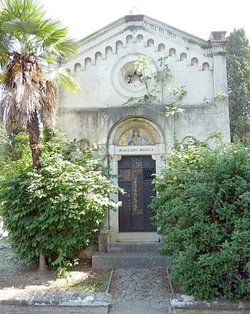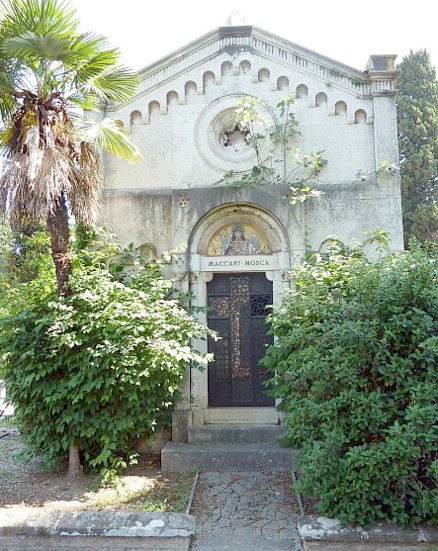His works were first bought by the Marquis Pieri-Nerli who commissioned him to paint frescoes of the four evangelists in his home in Quinciano, a hamlet in the comune of Monteroni d'Arbia.
His first important work, "Fabiola" is in Florence. His "Melody" followed. The "Descent from the Cross" is a grand composition, and shows a masterly handling of light and shade. The frescos on the ceiling of the royal chapel of the Sudario in Rome add greatly to the fame of Maccari. They were a commission from Victor Emmanuel. For the palace of the Quirinal in Rome, he executed a fresco of the "Triumph of the Three Graces".
For the chapel of the cemetery at Campo Veramo, Rome, a lunette, "Tobias burying the Dead".
In 1863, Maccari painted "Leonardo che ritrae la Gioconda" which won an award in 1865. In his home town of Siena he decorated the Sala del Risorgimento in the public palace with frescoes.
At Philadelphia, in 1876, were two of his works, "Fond Memories" and "Music hath Charms," for which he received a medal.
Between 1882 and 1888 Maccari painted a series of frescoes depicting Roman life at the Sala Maccari in the Salone d'Onore in Rome's Palazzo Madama, seat of the Italian Senate, amongst them his most famous work, "Cicero Denounces Catiline".
In later life Maccari became a lecturer at the Accademia di San Luca in Rome. He became paralyzed while working on the Palace of Justice in Rome in 1909 and as a result stopped working as an artist.
His works were first bought by the Marquis Pieri-Nerli who commissioned him to paint frescoes of the four evangelists in his home in Quinciano, a hamlet in the comune of Monteroni d'Arbia.
His first important work, "Fabiola" is in Florence. His "Melody" followed. The "Descent from the Cross" is a grand composition, and shows a masterly handling of light and shade. The frescos on the ceiling of the royal chapel of the Sudario in Rome add greatly to the fame of Maccari. They were a commission from Victor Emmanuel. For the palace of the Quirinal in Rome, he executed a fresco of the "Triumph of the Three Graces".
For the chapel of the cemetery at Campo Veramo, Rome, a lunette, "Tobias burying the Dead".
In 1863, Maccari painted "Leonardo che ritrae la Gioconda" which won an award in 1865. In his home town of Siena he decorated the Sala del Risorgimento in the public palace with frescoes.
At Philadelphia, in 1876, were two of his works, "Fond Memories" and "Music hath Charms," for which he received a medal.
Between 1882 and 1888 Maccari painted a series of frescoes depicting Roman life at the Sala Maccari in the Salone d'Onore in Rome's Palazzo Madama, seat of the Italian Senate, amongst them his most famous work, "Cicero Denounces Catiline".
In later life Maccari became a lecturer at the Accademia di San Luca in Rome. He became paralyzed while working on the Palace of Justice in Rome in 1909 and as a result stopped working as an artist.
Sponsored by Ancestry
Advertisement
Advertisement



